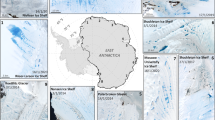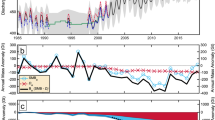Abstract
Large proglacial lakes cool regional summer climate because of their large heat capacity, and have been shown to modify precipitation through mesoscale atmospheric feedbacks, as in the case of Lake Agassiz1. Several large ice-dammed lakes, with a combined area twice that of the Caspian Sea, were formed in northern Eurasia about 90,000 years ago, during the last glacial period when an ice sheet centred over the Barents and Kara seas2 blocked the large northbound Russian rivers3. Here we present high-resolution simulations with an atmospheric general circulation model that explicitly simulates the surface mass balance of the ice sheet. We show that the main influence of the Eurasian proglacial lakes was a significant reduction of ice sheet melting at the southern margin of the Barents–Kara ice sheet through strong regional summer cooling over large parts of Russia. In our simulations, the summer melt reduction clearly outweighs lake-induced decreases in moisture and hence snowfall, such as has been reported earlier for Lake Agassiz1. We conclude that the summer cooling mechanism from proglacial lakes accelerated ice sheet growth and delayed ice sheet decay in Eurasia and probably also in North America.
This is a preview of subscription content, access via your institution
Access options
Subscribe to this journal
Receive 51 print issues and online access
$199.00 per year
only $3.90 per issue
Buy this article
- Purchase on Springer Link
- Instant access to full article PDF
Prices may be subject to local taxes which are calculated during checkout



Similar content being viewed by others
References
Hostetler, S. W., Bartlein, P. J., Clark, P. U., Small, E. E. & Solomon, A. M. Simulated influences of Lake Agassiz on the climate of central North America 11,000 years ago. Nature 405, 334–337 (2000)
Svendsen, J. I. et al. Late Quaternary ice sheet history of Eurasia. Quat. Sci. Rev (in the press)
Mangerud, J., Astakhov, V., Jakobsson, M. & Svendsen, J. I. Huge ice-age lakes in Russia. J. Quat. Sci. 16, 773–777 (2001)
Lundquist, J. Glacial stratigraphy in Sweden. Spec. Pap. Geol. Surv. Finl. 15, 43–59 (1992)
Legates, D. R. & Willmott, C. J. Mean seasonal and spatial variability in global surface air temperature. Theor. Appl. Climatol. 41, 11–21 (1990)
Legates, D. R. & Willmott, C. J. Mean seasonal and spatial variability in gauge-corrected, global precipitation. Int. J. Climatol. 10, 111–127 (1990)
Genthon, C. & Krinner, G. Antarctic surface mass balance and systematic biases in general circulation models. J. Geophys. Res. 106, 20653–20664 (2001)
Krinner, G. & Werner, M. Impact of precipitation seasonality changes on isotopic signals in polar ice cores: A multi-model analysis. Earth Planet. Sci. Lett. 216, 525–538 (2003)
Nelson, F. & Outcalt, S. I. A computational method for prediction and regionalization of permafrost. Arct. Alp. Res. 19, 279–288 (1987)
Mangerud, J., Astakhov, V., Murray, A. & Svendsen, J. I. The chronology of a large ice-dammed lake and the Barents–Kara ice sheet advances, Northern Russia. Glob. Planet. Change 31, 321–336 (2001)
Mangerud, J. et al. Ice-dammed lakes and rerouting of the drainage of northern Eurasia during the last glaciation. Quat. Sci. Rev. (in the press)
Thompson, S. L. & Pollard, D. Greenland and Antarctic mass balances for present and doubled atmospheric CO2 from the GENESIS version-2 global climate model. J. Clim. 10, 871–900 (1997)
Teller, J. T. in The Quaternary Period in the United States (eds Gillespie, A., Porter, S. & Atwater, B.) Ch. 3 (Elsevier, Amsterdam, 2003)
Khodri, M. et al. Simulating the amplification of orbital forcing by ocean feedbacks in the last glaciation. Nature 410, 570–574 (2001)
de Noblet, N. et al. Possible role of atmosphere-biosphere interactions in triggering the last glaciation. Geophys. Res. Lett. 23, 3191–3194 (1996)
Gallimore, R. G. & Kutzbach, J. E. Role of orbitally induced changes in tundra area in the onset of glaciation. Nature 381, 503–505 (1996)
Shackleton, N. J. The 100,000-year ice-age cycle identified and found to lag temperature, carbon dioxide, and orbital eccentricity. Science 289, 1897–1902 (2000)
Berger, A. Long-term variations of daily insolation and Quaternary climatic changes. J. Atmos. Sci. 35, 2362–2367 (1978)
Clarke, G., Leverington, D., Teller, J. & Dyke, A. Superlakes, megafloods, and abrupt climate change. Science 301, 922–923 (2003)
Krinner, G., Genthon, C., Li, L. & Le Van, P. Studies of the Antarctic climate using a stretched-grid general circulation model. J. Geophys. Res. 102, 13731–13745 (1997)
Krinner, G. Impact of lakes and wetlands on boreal climate. J. Geophys. Res. D 108, 101029/2002JD002597 (2003)
Petit, J.-R. et al. Climate and atmospheric history of the past 420,000 years from the Vostok ice core, Antarctica. Nature 399, 426–436 (1999)
Siegert, M. J., Dowdeswell, J. A., Hald, M. & Svendsen, J. I. Modelling the Eurasian ice sheet through a full (Weichselian) glacial cycle. Glob. Planet. Change 31, 367–385 (2001)
Marshall, S. J., Tarasov, L., Clarke, G. & Peltier, W. R. Glaciological reconstruction of the Laurentide Ice Sheet: Physical processes and modelling challenges. Can. J. Earth Sci. 37, 769–793 (2000)
Charbit, S., Ritz, C. & Ramstein, G. Simulations of Northern Hemisphere ice-sheet retreat: Sensitivity to physical mechanisms involved during the Last Deglaciation. Quat. Sci. Rev. 21, 243–266 (2002)
Crucifix, M., Loutre, M. F., Tulkens, P., Fichefet, T. & Berger, A. Climate evolution during the Holocene: a study with an Earth system model of intermediate complexity. Clim. Dyn. 19, 43–60 (2002)
Crowley, T. Ice age terrestrial carbon changes revisited. Glob. Biogeochem. Cycles 9, 377–389 (1995)
Acknowledgements
We thank S. Hostetler for discussions and M. Siegert for comments and suggestions. Model simulations were carried out at IDRIS/CNRS. This work was supported by the ESF and the French national programmes ECLIPSE, PNEDC and ACI Jeunes Chercheurs. The field work and other analyses were funded by the Research Council of Norway by grants to the PECHORA project. M.J. was supported by NOAA.
Author information
Authors and Affiliations
Corresponding author
Ethics declarations
Competing interests
The authors declare that they have no competing financial interests.
Rights and permissions
About this article
Cite this article
Krinner, G., Mangerud, J., Jakobsson, M. et al. Enhanced ice sheet growth in Eurasia owing to adjacent ice-dammed lakes. Nature 427, 429–432 (2004). https://doi.org/10.1038/nature02233
Received:
Accepted:
Issue Date:
DOI: https://doi.org/10.1038/nature02233
This article is cited by
-
Reconstructing Lake Onego evolution during and after the Late Weichselian glaciation with special reference to water volume and area estimations
Journal of Paleolimnology (2019)
-
Mass balance and near-surface ice temperature structure of Baishui Glacier No.1 in Mt. Yulong
Journal of Geographical Sciences (2013)
-
The sensitivity of the Late Saalian (140 ka) and LGM (21 ka) Eurasian ice sheets to sea surface conditions
Climate Dynamics (2011)
-
Impact of prescribed Arctic sea ice thickness in simulations of the present and future climate
Climate Dynamics (2010)
-
A retrospective look at coupled ice sheet–climate modeling
Climatic Change (2010)
Comments
By submitting a comment you agree to abide by our Terms and Community Guidelines. If you find something abusive or that does not comply with our terms or guidelines please flag it as inappropriate.



